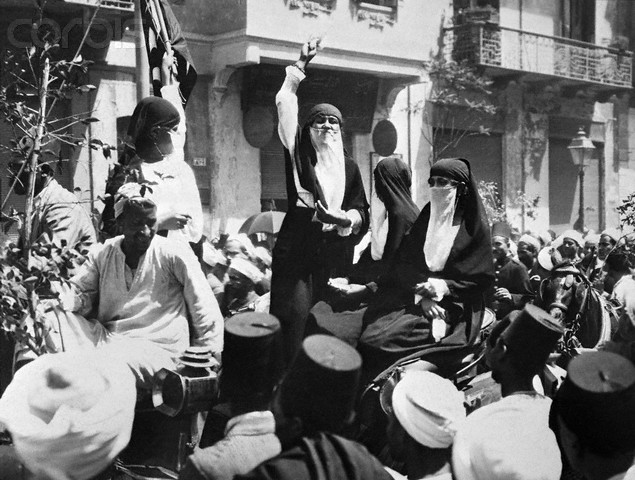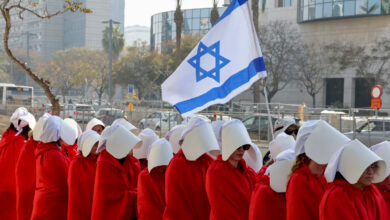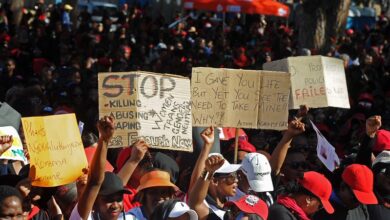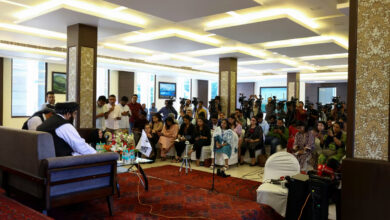
On 24 May 1919, an unidentified photographer shot a scene in which a woman with her face veiled addressed a group of Egyptians at a protest against British colonizers amid a nascent rebellion. The original caption of the photo exalts what was then considered a remarkable act. “Cairo women addressing a crowd in one of the principal streets of the Egyptian City,” the caption reads, referring to the other women accompanying her. “The speaker is urging greater patriotism and loyalty to their land. During her speech she cried for cheer for her land, for liberty and President Wilson. This is the first time in history that Egyptian women have been permitted freedom of speech in public. Their appearance in the thoroughfare quickly caused a great crowd to gather.”
It is up to historians and scholars to trace whether this was indeed the first time in history an Egyptian woman freely addressed a crowd in the street, but what’s uncontested is that this was a pivotal moment.
The 1919 revolt was an early and notable point in history that showcased Egyptians’ unity toward a collective aim, namely to overthrow the British occupation. Remembering this moment and revisiting what it has produced in terms of socio-political and cultural transformations, and what role women played, is especially relevant at a time when Egyptians are fixated on another historic revolution that toppled the authoritarian rule of Hosni Mubarak.
Reminiscent images
During the 18-day uprising against Mubarak in January 2011, hundreds of images were brought to us featuring Egyptian women on podiums in Tahrir Square talking to the crowds. Such images were reminiscent of the 1919 revolt where women were seen in the streets, protesting for the first time in modern Egypt.
In both images, women joined men to raise one unified demand: that Egypt should be liberated.
The images also remind us that women were killed in both revolutions. Huda al-Sayed was shot dead by police during the first days of the 25 January revolution and Hameeda Khalil was shot dead by British forces on 14 March 1919.
Like men, women shared the burden of discontent from the state of colonization and, years later, dictatorship, which prompted their active participation in these revolts, reiterating an equal sense of engagement and belonging.
But one lesson from 1919 has been that when the revolution succeeds, people who protested are not necessarily those propelled to power. More importantly, the social transformations manifested during the act of revolting in 1919 were not quickly incorporated into mainstream society in the years to follow. This might ease the anxiety over the implications of the 2011 revolution. A year after Mubarak’s ouster through a popular outcry in which women’s presence was undeniable, it is still too early to determine whether they will reap the benefits of the revolution or just be a sacrifice for it.
In both revolutions, women were officially praised for their patriotism. In the statements of the ruling Supreme Council of the Armed Forces, the generals recognized the seminal role played by women in the revolution. Similarly, national leader Saad Zaghloul expressed his gratitude for the role of women upon his return from political exile in 1923, saying, "Long live Egyptian women" in a dramatic statement.
Beyond the official discourse lies a more problematic reality. The 2012 International Women's Day comes one day before the first anniversary of the incident when scores of women were arrested at a sit-in in Tahrir Square and some of them subjected to virginity tests by the military. Throughout the past year, public discourse has been indicative of a finished show in which women have served their purpose of symbolizing how the revolution brought people together and no longer need to protest.
Prominent historian Abdel Rahman al-Rafei’s words in 1949 reflect the same sentiment. He praised women for their participation in the protests of the 1919 revolution, but then limited the role of women to easing the pain of the poor and the sick. His three detailed volumes about Egypt after the 1919 revolution strangely overlook the various demands drawn by the rising feminist movement in the country.
Looking back
On 28 February 1922, Egypt achieved its independence. In fact, it wasn’t real independence, but a Unilateral Declaration of Egyptian Independence in which London indicated: “The British Protectorate over Egypt is terminated, and Egypt is declared to be an independent sovereign state.”
However, this nominal independence was perceived as a victory. Egyptians became the source of authority and a new constitution was drafted. Scores of laws were issued to exercise a new era of independence and modernity. But these laws enshrined an abundance of flaws where women were concerned, which was also a point of departure for a dynamic feminist movement.
For example, Law 11 issued by Prime Minister Yehia Ibrahim on 30 April 1923 stipulated that "every Egyptian male adult over the age of 21 has the right to vote.”
The law was contested by the young rebel Mounira Thabet (1906–1967) who publicly criticized national leaders for excluding women from their right to vote. Thabet established a weekly magazine called “Al-Amal” (Hope), advocating women’s suffrage and speaking loudly for amending the personal status laws that impose restrictions on marriage and divorce.
Less radical was Hoda Shaarawi (1879–1947), who advocated a conciliatory approach in which she thought women should be encouraged to have a greater presence in the public sphere. Shaarawi’s call had a seminal impact. She was the wife of national leader Ali Shaarawy Pasha, one of Zaghloul’s allies, and benefiting from her husband’s connections, she extended her activism to larger circles. She founded the Egyptian Feminist Union, which enjoyed a high degree of recognition until World War II. Newspapers and magazines at the time celebrated Shaarawi as a leader and symbol for the Egyptian renaissance. She managed to create a place for women's issues in the public domain.
Parallel her rise, there was also the stardom of Safia Mustafa Fahmy (1876–1946), also known as Safia Zaghloul, who tried to wriggle out of the bad reputation of her father, Mustafa Fahmy Pasha (described as one of the worst prime ministers in Egypt’s history), by serving as a mother to her people and a respected ideal for women.
Shaarawi and Zaghloul could be seen as “women with privileges.” They both came from elite families with money. But not all women leading the feminist movement share the same background.
For example, activist Nabaweya Moussa (1886–1951) hailed from a middle-class background. She was one of the main figures who advocated education for women. She was also the first female headmaster in the country.
The list of feminist activists before World War II also includes the politically active Siza Nabrawy (1897–1985), who went with Shaarawi and Moussa to Rome in May 1923 to represent their country at the Women's International Conference. She was also a co-founder of the Egyptian Feminist Union.
Women’s history following the 1919 revolt is not limited to activism alone. Other figures played critical roles in the social transformation of gender relations and perception of women in 20th century Egypt.
Fatma al-Youssef is a notable example. Working as an actress, which was considered an unsuitable career for women at the time, Youssef continued her struggle, and eventually changed hats by becoming a journalist. She established the political magazine Rose al-Youssef, one of the country’s flagship publications, while leaving behind a career in acting for the possibility of renegotiating the image of women in the public sphere.
Lebanese actress and film producer Assia Dagher (1901–1986), actress Fatma Rushdi (1908–1996), and actress Amina Rizk (1910–2003) became symbols of a changing public perception as they successfully pursued acting careers while enriching the country’s evolving film industry.
And of course, women’s history could not be written without including one of the country’s most legendary artistic figures: Om Kalthoum (1898–1975) the singing diva, whose influence transcends the fields of music to horizons of nationalism and politics. For one, she is a significant example of how a woman can challenge the often insurmountable circumstances of poverty and become a source of inspiration for many generations.
From 1925 until the end of World War II, these figures managed to unsettle traditional society’s perception of women. They were accepted by the broader society for different reasons, be it the symbolic role of Zaghloul, or the charity work done by Shaarawi. Many others demonstrated that they could successfully compete with men in professional fields such as education and journalism.
But the revival of such remarkable roles remains questionable. Up until World War II, meager achievements were made in women’s political rights. The labor laws governing the work of women remained arbitrary. For example, the debate about prostitution entailed a narrow vision prohibiting sexual contact outside the institution of marriage, without any consideration for the physical and psychological exploitation incurred in prostitution. Problematic personal status laws remained untouched as if they were taboos.
By the end of World War II, the role of Egyptian women was rejuvenated, pushing for a more robust women’s movement away from the traditions that ruled the previous generations. The community saw women graduating from universities and working as journalists, doctors, teachers and political activists.
Names such as Doria Shafik, Engy Aflaton, Latifa al-Zayat, Zeinab al-Ghazali, Bint al-Shatei and others, despite their different ideologies, managed to move past the traditions that dominated the women's movement, largely due to the inability of the older generation to cope with the rapid changes of the 1940s.




